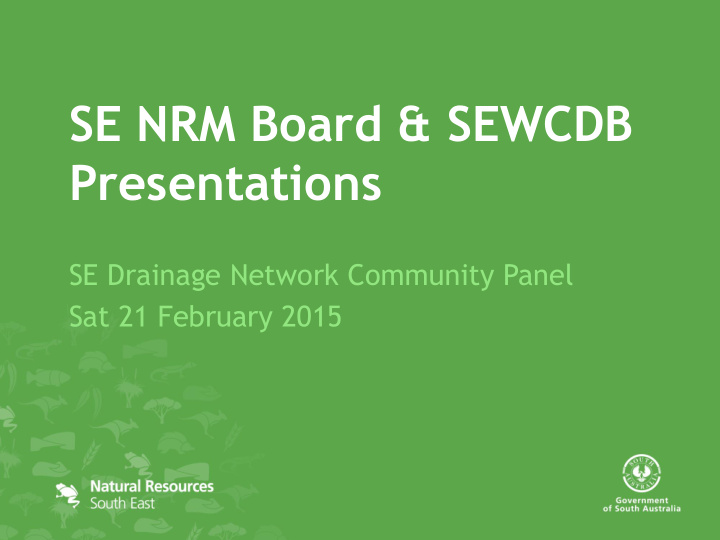



SE NRM Board & SEWCDB Presentations SE Drainage Network Community Panel Sat 21 February 2015
South East Natural Resources Management Board Presentation to the South East Drainage Network Community Panel 21 st Feb 2015
South East Natural Resources Management Board Cooperation with SE Water Conservation & Drainage Board NRM Act 2004 Regional NRM Plan – guides regional NRM activities
South East Natural Resources Management Board South East Drainage & Wetland Strategy Integrated groundwater & surface water management Balance of the multiple functions of the drainage network
South East Natural Resources Management Board • How much funding is required? • Benefits of the Drainage Network Environmental Outcomes Economic Outcomes Social Outcomes
South East Natural Resources Management Board Principles for Revenue Raising • Fairness • Efficiency • Accountability
South Eastern Water Conservation & Drainage Board Presentation to the Community Panel
South East Water Conservation & Drainage Board
South Eastern Water Conservation & Drainage Board Act (7) (a) The prevention or minimisation of damage to agricultural production and the natural environment caused by flooding within the South east; and (b) the improvement of the soil quality and the productiveness generally of rural lands in the South East; and (c) the enhancement or development of natural wetlands and the natural environment generally in the South East.
Legislative obligations... • Effectively managing the surface water of the non- urban lands in the South east , by conserving, draining, altering the flow of or utilising that water in any manner • Carrying out works to lower the level of the water table of lands in the South east • Undertake , assist or promote research in the fields of water conservation , drainage and management. • Enhancement or development of natural wetlands and the natural environment generally in the South East.
Management Plan (1).... OUR ROLE: To manage and conserve the quality and flow of water by effectively managing flooding, redirecting water to areas of greatest need and reducing salinity. Maintain Drains Operate Manage Water Policy Governance & and Assets Drainage System regimes of Administration Development • Operate Connected • Policy for • Meet statutory regulators Wetlands • Risk work on private requirements • Direct water assessments • Direct water land • Occupational • Develop • Weed control • Operate • Extraction health & safety operating regulators • Silt removal from drains • Finance guidelines • Develop management • Infrastructure • Undertake organisational maintenance • Ministerial measures for the (e.g. painting of policies accountability conservation & bridges and management of weirs) native species Drainage System Monitoring, Information and Science • Monitor the impacts of delivery of water on receiving environments • Adaptive management for water flows • Supporting targeted research initiatives Regional Communications & Engagement Communications and engagement activities with landholders, government, industry, community and other stakeholders groups
Management Plan (2).... Strategic Context (i.e. National & State legislative drivers and strategies, Regional specific legislation & Plans Operational Context Goal 1: Sustainable productive Agriculture Goal 2: Sustainable Water dependant Ecosystems Goal 3: Informed and Engaged Communities Goal 4: Legislative , Policy and Corporate Governance Goal 5: Drainage System Monitoring, Information & Science.
Two distinct Areas • Lower South East – 8 Mile Creek area – challenges with unstable soils – Remaining areas - 20 year rotation for silt removal in stable soils • Upper South East – Erosion problems – Adaptive flows management (balancing dryland salinity, flood mitigation and environmental flows ) – SEFRP (Coorong, Lower Lakes & Murray Mouth outcomes)
Cost Impacts: Activity Requirem Requirem Description In summary.. ent in LSE ent in USE Capital Very high low Infrastructure at end of service replacement life in LSE; newly constructed • Capital Replacement & infrastructure in USE Capital Very high Low to Infrastructure at end of service Maintenance of infrastructure maintenance moderate life in LSE; newly constructed infrastructure in USE, some • Silt Maintenance requires improvement. Silt removal high Very high LSE Drains require cleaning on a 10-20 year rotation to maintain a • Track Maintenance 1:10 flow capacity; USE Drains require frequent/additional • Weed control erosion control works to maintain channels. • Flows management & monitoring Track low Very high USE Drains require maintenance frequent/additional erosion control works to maintain access tracks. Weeds and high high Similar demands for controlling vegetation noxious weeds and growth in removal channels exists in both districts. Flows low high The USE drainage network was Management specifically designed for the and active management of water to monitoring achieve multiple objectives; the Table from page 3 of SEWCDB submission LSE drains were designed primarily for flood mitigation, and demands are increasing for retrofit to increase management capabilities
Cost Impacts- what should happen Adequate ongoing investment to the SEWCD Board will maintain the SEDN close to design standard. Design standard PERFORMANCE, Drain Assets withstand a 1 in 10 year flood event Regular investment prevents Performance of structures $ COST asset Deterioration is maintained over time Long-term costs remain manageable TIME (YEARS)
Reality- investment over time... The SEWCD Board wishes to maintain the SEDN to a standard of design to withstand a 1in 10 year flood event . Consistent and adequate rate of investment required for optimum maintenance and performance No investment results in increasing maintenance Maintenance is required and significant preventable to maintain standard to withstand a costs 1 in 10 year flood event Performance will decline over time if not maintained $ INVESTMENT Restoration costs increase without maintenance Performance decreases with declining investment Decreasing investment = decline in performance and function $0 TIME (YEARS)
Recommend
More recommend